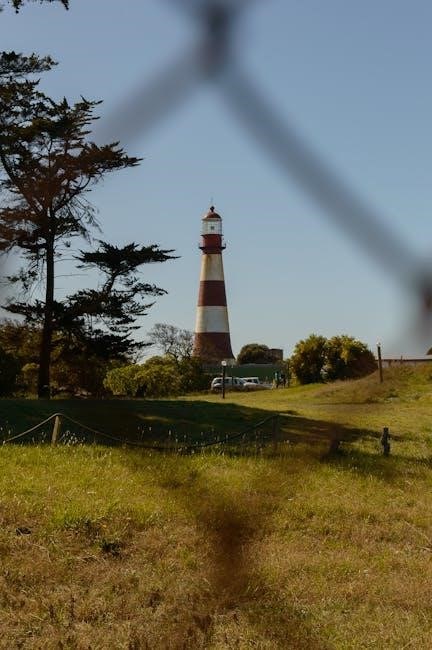Monkeywrenching is a form of direct action environmentalism, blending sabotage with civil disobedience to protect ecosystems. Popularized by Dave Foreman’s Ecodefense, it advocates radical methods to halt ecological destruction, inspiring modern environmental movements and sparking debates on ethics and effectiveness.
Definition and Overview
Monkeywrenching, also known as ecological sabotage, is a form of direct action environmentalism. It involves nonviolent, illegal tactics like tree spiking or machine sabotage to disrupt industrial activities harming ecosystems. Popularized by Dave Foreman’s Ecodefense: A Field Guide to Monkeywrenching, it emphasizes protecting biodiversity and wildlife through radical, hands-on methods. This approach sparks debate, balancing its effectiveness in halting destruction with legal and ethical concerns.
Historical Context and Evolution
Monkeywrenching emerged in the 1980s as a radical response to environmental destruction. Inspired by Edward Abbey’s The Monkeywrench Gang, it gained momentum with Dave Foreman’s Ecodefense in 1985. Initially associated with EarthFirst!, the movement evolved to include diverse tactics and global activism. Over time, it incorporated modern strategies like cyber activism, reflecting its adaptability in addressing contemporary environmental challenges while maintaining its core philosophy of direct action to protect ecosystems.
Key Objectives and Philosophy
Monkeywrenching aims to disrupt ecological destruction through direct action, prioritizing the protection of ecosystems over human interests. Its philosophy, rooted in deep ecology, emphasizes the intrinsic value of nature. Practitioners believe that conventional activism is insufficient, necessitating bold, often illegal tactics. The movement advocates for the preservation of wilderness and the dismantling of industrial systems harming the environment, blending radical activism with a moral imperative to safeguard the planet for future generations.

Key Figures in Monkeywrenching
Monkeywrenching relies on passionate individuals and activists who inspire and organize direct actions. Key figures have shaped the movement’s tactics and philosophical foundations over time.
Dave Foreman and the Founding of EarthFirst!
Dave Foreman, a visionary environmentalist, co-founded EarthFirst! in 1980, becoming a central figure in monkeywrenching. Drawing inspiration from Edward Abbey’s The Monkey Wrench Gang, Foreman advocated radical action to protect wilderness. EarthFirst! embraced direct tactics like tree spiking and road blockades, rejecting mainstream environmentalism’s compromise. Foreman’s leadership galvanized a movement, blending ecological militancy with a deep love for nature, inspiring activists to take bold, unconventional steps to defend ecosystems and challenge industrial exploitation.
Edward Abbey: A Literary Icon of Environmental Activism
Edward Abbey, a celebrated author and environmentalist, became a symbol of radical activism through his novel The Monkey Wrench Gang. His vivid portrayal of eco-sabotage inspired the monkeywrenching movement, advocating direct action to protect wildlands from industrial destruction. Abbey’s philosophy blended anarchism and deep ecology, critiquing modern society’s exploitation of nature. His writings continue to influence environmentalists, offering a literary and ideological foundation for those willing to challenge the status quo in defense of the Earth.
Mike Roselle and the Modern Movement
Mike Roselle, a prominent environmental activist, has revitalized monkeywrenching in the 21st century. As a co-founder of EarthFirst! and the Rainforest Action Network, Roselle championed direct action tactics to halt environmental destruction. His modern approach integrates technology and grassroots organizing, inspiring a new generation of activists. Roselle’s work emphasizes the importance of strategic sabotage to protect ecosystems, blending traditional monkeywrenching with contemporary activism to address urgent environmental challenges and spark systemic change.
Philosophical Underpinnings
Philosophical underpinnings of monkeywrenching emphasize deep ecology, viewing nature as inherently valuable. Civil disobedience is justified to protect ecosystems, blending radical action with ethical environmental stewardship.
Deep Ecology and Its Influence
Deep ecology, a philosophical framework emphasizing nature’s intrinsic value, profoundly influences monkeywrenching. It advocates for radical environmental protection, prioritizing ecosystems over human interests. This ideology, popularized by Arne Naess, encourages direct action to preserve biodiversity and ecological balance. Monkeywrenching adopts these principles, justifying sabotage as a means to defend the land. By framing nature as a subject with rights, deep ecology provides a moral foundation for confronting industrial destruction, inspiring activists to take bold, uncompromising stands for environmental preservation.
The Role of Civil Disobedience
Civil disobedience plays a central role in monkeywrenching, serving as a non-violent yet direct challenge to oppressive systems. Activists employ illegal tactics like tree sitting or road blockades to disrupt environmentally harmful activities. This approach, rooted in moral conviction, aims to highlight injustices and spark public debate. By breaking laws, practitioners assert that protecting the planet outweighs legal consequences, inspiring others to question authority and take action for environmental justice and ecological preservation.
Ethical Considerations in Environmental Activism
Ethical dilemmas arise in monkeywrenching, as activists weigh the consequences of their actions. While the goal is environmental protection, methods like sabotage can harm people or ecosystems unintentionally. Activists must consider the moral implications of breaking laws and causing damage, balancing short-term disruption with long-term ecological benefits. Ethical frameworks often emphasize non-violence and minimizing harm, ensuring actions align with broader principles of justice and sustainability. These debates shape the movement’s moral compass and public perception.

Tactics and Strategies
Monkeywrenching employs diverse strategies to disrupt environmentally harmful activities, from tree spiking to machine sabotage. These tactics aim to halt destruction while minimizing harm to life and ecosystems.
Tree Spiking: Methods and Controversies
Tree spiking involves hammering metal spikes into trees to prevent logging. This tactic aims to protect forests by making timber extraction dangerous and costly. While effective, it sparks debate due to risks of injuring loggers and legal repercussions. Critics argue it fosters violence, while supporters see it as a desperate measure. The controversy highlights ethical dilemmas in radical environmentalism, questioning the balance between preserving nature and human safety. Its use remains divisive within activist circles. Controversies surrounding tree spiking have led to both admiration and condemnation, shaping its legacy in environmental activism.
Billboarding: Altering Public Spaces
Billboarding involves altering public advertisements to challenge corporate narratives and promote environmental messages. Activists often replace or modify billboard content to highlight ecological issues. This tactic aims to subvert mass media and engage the public directly. While it raises awareness, it risks legal consequences for vandalism. Critics argue it blurs the line between protest and property damage. Despite this, billboarding remains a bold strategy to reclaim public spaces and spark dialogue on environmental exploitation. Its impact lies in its visibility and ability to provoke thought. Controversies surrounding billboarding reflect broader debates on free speech and corporate influence.
Machine Sabotage: Targeting Industrial Equipment
Machine sabotage involves disabling or destroying industrial equipment to disrupt activities harming the environment. Tactics include tampering with machinery, such as logging or mining equipment, to halt operations. While effective in curbing industrial damage, this method carries significant risks, including legal consequences and potential safety hazards. Proponents argue it directly confronts environmental destruction, but critics warn of its controversial nature and ethical dilemmas. Risks and consequences must be carefully weighed in such actions. Examples include targeting logging equipment to protect old-growth forests or disabling mining gear to prevent pollution.
Digital Age Tactics: Cyber Activism and Beyond
In the digital age, monkeywrenching has evolved to include cyber activism as a powerful tool. Activists now use hacking, data leaks, and online disruptions to target corporations and governments. Tactics like DDoS attacks on industrial websites or exposing environmental violations through whistleblowing platforms have gained prominence. These methods allow for global reach and anonymous action, bypassing physical barriers. While effective, they carry legal risks and ethical debates, as they blur the line between activism and cybercrime. Digital sabotage remains a controversial yet evolving strategy in environmental resistance.

Legal and Ethical Considerations
Monkeywrenching often involves illegal acts, leading to criminal charges for vandalism, trespassing, or sabotage. Ethical debates arise over property rights, environmental protection, and potential harm to humans or wildlife. Activists must weigh personal morals against broader ecological goals, navigating a complex web of legal and moral responsibilities. These dilemmas define the controversial nature of environmental sabotage.
Legal Consequences of Monkeywrenching
Monkeywrenching often leads to criminal charges, including vandalism, trespassing, and sabotage. Perpetrators may face fines, imprisonment, or both. In severe cases, acts of sabotage can be classified as felonies or even domestic terrorism under federal laws. Law enforcement agencies actively pursue those involved, and convictions can result in lengthy prison sentences. Additionally, organizations linked to monkeywrenching activities may face legal repercussions, including lawsuits and asset seizures. These legal risks underscore the high-stakes nature of environmental sabotage.
Moral Dilemmas in Environmental Sabotage
Monkeywrenching raises ethical concerns, as it often involves property damage or harm to human interests. While activists argue their actions protect ecosystems, critics question the morality of destroying property or risking human safety. The tactic challenges the balance between environmental preservation and respect for human-made systems. It sparks debates about whether ends justify means and the ethical limits of radical activism in pursuing ecological goals.
Public Perception and Media Impact
Monkeywrenching often sparks polarized public reactions, with some viewing it as heroic resistance and others as reckless vandalism. Media coverage amplifies this divide, shaping perceptions based on framing; Activists leverage media to highlight environmental causes, while critics emphasize property damage and risks. The tactic’s controversial nature ensures significant attention, influencing public opinion and debates about activism’s role in environmentalism. Media narratives play a crucial role in swaying support or condemnation of these direct-action strategies.

Environmental Impact
Monkeywrenching aims to protect ecosystems by disrupting harmful activities, yet it risks unintended environmental harm, sparking debates about its ecological benefits versus collateral damage.
Assessing the Effectiveness of Monkeywrenching
Monkeywrenching’s effectiveness is debated, with some arguing it halts environmental destruction directly, while others criticize its lack of long-term systemic change. Actions like tree spiking or equipment sabotage often delay projects but may not address root causes. Critics argue that such tactics can alienate public support and provoke harsher legal crackdowns. Despite this, monkeywrenching remains a controversial yet influential approach in environmental activism, sparking discussions about its role in achieving ecological goals versus perpetuating conflict.
Positive Outcomes: Protecting Ecosystems
Monkeywrenching has successfully protected ecosystems by halting destructive practices like logging, mining, and construction. Actions such as tree spiking and equipment sabotage have preserved forests, safeguarded wildlife habitats, and defended water sources. These interventions often buy time for legal battles or public awareness campaigns, ensuring ecosystems remain intact. By targeting specific threats, monkeywrenching has demonstrated its ability to shield vulnerable environments from irreversible harm, embodying a direct approach to environmental conservation.
Negative Consequences: Unintended Harm
Monkeywrenching can lead to unintended harm, such as injuries from tree spiking or equipment sabotage. These actions may escalate conflicts, prompting aggressive countermeasures. Additionally, they can alienate potential supporters, who may view the tactics as extreme. Legal crackdowns often follow, restricting broader environmental activism. Such strategies can also undermine negotiations, fostering mistrust and hindering collaborative solutions. The risk of causing unintended harm emphasizes the need for careful consideration in employing these methods.

Case Studies
Historic acts like the 1985 sabotage of logging equipment in California’s redwoods highlight monkeywrenching’s real-world application, blending activism with direct action to protect ecosystems and challenge industrial practices.
Notable Acts of Monkeywrenching in History
Notable acts include the 1985 sabotage of logging equipment in California’s redwoods, delaying timber operations. EarthFirst! famously toppled power lines in 1989 to protest uranium mining. Tree spiking in the 1990s saved old-growth forests from logging. These actions, while controversial, drew attention to environmental causes and inspired broader activism, showcasing monkeywrenching’s ability to disrupt harmful practices and spark public debate.
Success Stories: When Tactics Worked
Monkeywrenching tactics have successfully protected numerous ecosystems. In the 1980s, activists used tree spiking and blockades to save old-growth forests, influencing public opinion and leading to policy changes. Similarly, actions against nuclear projects delayed harmful developments. These successes demonstrate the strategic effectiveness of direct action in environmental activism, inspiring future efforts to defend the planet. The lasting impact of these actions underscores their importance in the fight against environmental destruction.
Failures and Lessons Learned
While monkeywrenching has achieved victories, some actions backfired, causing unintended harm or public backlash. For instance, tree spiking sometimes injured workers, undermining support. Other campaigns faced legal repercussions, weakening the movement. These failures taught activists the importance of precise planning, ethical considerations, and minimizing collateral damage. Lessons learned emphasize the need for strategic clarity and public engagement to sustain long-term effectiveness and maintain moral high ground in environmental defense.

Modern Applications
Monkeywrenching today incorporates digital activism, cyber protests, and social media campaigns, blending traditional tactics with modern tools to address contemporary environmental crises and technological advancements.
Monkeywrenching in the 21st Century
Monkeywrenching has evolved in the 21st century, integrating digital activism and modern technologies. Activists now use social media, hacktivism, and drones to disrupt environmentally harmful projects. Cyber protests and data leaks expose corporate wrongdoing, while traditional tactics like tree spiking and sabotage continue. The rise of climate urgency has sparked new forms of resistance, blending old-school environmentalism with contemporary tools. This fusion of methods highlights the adaptability of monkeywrenching in addressing modern ecological crises.
Intersection with Other Activist Movements
Monkeywrenching has intersected with various activist movements, including Occupy Wall Street, Black Lives Matter, and labor rights. These alliances highlight shared goals of challenging systemic oppression and corporate power. Environmental activists often collaborate with social justice groups, recognizing the interconnection between ecological destruction and human rights. This cross-movement solidarity strengthens resistance, enabling broader coalitions to address intersecting crises like climate change and economic inequality.
The Future of Environmental Sabotage
Environmental sabotage is likely to evolve with advancing technology and global crises. Activists may adopt more sophisticated digital tools and strategies, blending traditional tactics with modern innovations. Climate urgency and growing public awareness could inspire new waves of direct action. However, stricter surveillance and legal crackdowns pose challenges. The future may see a balance between covert operations and public advocacy, as movements adapt to safeguard ecosystems while navigating shifting political and societal landscapes.
Monkeywrenching remains a controversial yet powerful tool in environmental defense, demanding courage and sacrifice. Its legacy challenges individuals to reflect on their role in protecting the planet.
Final Thoughts on Monkeywrenching
Monkeywrenching, as a radical form of environmental activism, sparks intense debate. While it challenges destructive practices, its controversial methods raise ethical and legal questions. The movement’s impact on modern environmentalism is undeniable, inspiring both admiration and criticism. As the world grapples with ecological crises, monkeywrenching remains a polarizing yet thought-provoking strategy, urging individuals to reflect on their commitment to environmental justice and the boundaries of activism.
Call to Action for Environmentalists
Environmentalists must take bold action to protect the planet. Monkeywrenching offers a radical approach, but it demands careful consideration of ethics and consequences. Whether through direct action or advocacy, individuals can make a difference. Learn about environmental issues, engage with communities, and support organizations fighting for ecological justice. Every effort, no matter the size, contributes to a larger movement. The time to act is now—pledge to defend the Earth with passion, responsibility, and unwavering commitment.

References
Key Sources and Further Reading
- Ecodefense: A Field Guide to Monkeywrenching by Dave Foreman.
- The Monkey Wrench Gang by Edward Abbey.
- EarthFirst! journals and publications.
For deeper insights into monkeywrenching, consult Ecodefense: A Field Guide to Monkeywrenching by Dave Foreman, a foundational text on environmental sabotage.
- The Monkey Wrench Gang by Edward Abbey for a literary perspective.
- EarthFirst! journals and publications for real-world applications.
- Academic studies on environmental activism for broader context.
Explore online archives and activist platforms for updated tactics and debates.

Further Reading
Explore Ecodefense: A Field Guide to Monkeywrenching and works by Edward Abbey for deeper insights into environmental activism and sabotage tactics.
- Academic articles on environmental movements.
- Documentaries on radical activism.
- Online forums discussing modern monkeywrenching strategies.
Recommended Literature on Environmental Activism
For a deeper understanding of monkeywrenching, explore Ecodefense: A Field Guide to Monkeywrenching, a controversial handbook detailing radical environmental tactics. Edward Abbey’s The Monkey Wrench Gang offers a fictional yet inspiring account of ecological sabotage. Works by Dave Foreman and Derrick Jensen provide philosophical and practical insights into radical environmentalism; These texts challenge readers to rethink their relationship with nature and consider direct action as a means of environmental protection.

About the Author
Dave Foreman, a co-founder of EarthFirst!, is a prominent environmental activist and author. His work has significantly influenced radical environmentalism and the philosophy of monkeywrenching.
Dave Foreman and His Contributions
Dave Foreman, a co-founder of EarthFirst!, is a pivotal figure in environmental activism. His book, The Field Guide to Monkeywrenching, detailed unconventional tactics to protect the environment, blending philosophy with practical strategies. Foreman’s work emphasized direct action, inspiring radical environmentalism. His contributions have sparked both admiration and controversy, shaping modern ecological resistance. His legacy continues to influence activists, advocating for the preservation of wildlands and challenging industrial exploitation.